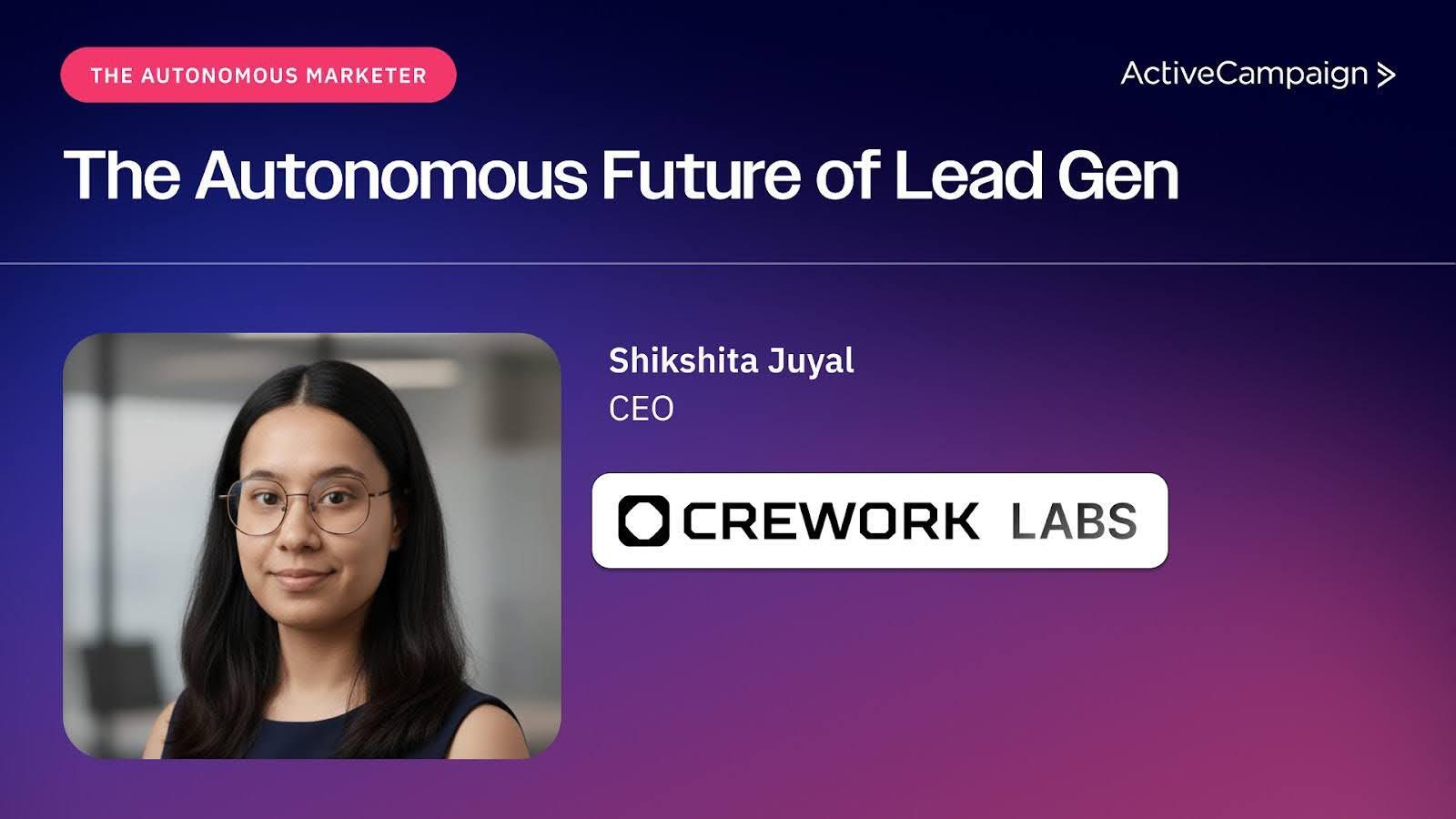It’s time to get the word out about your new business.
How do you create awareness quickly? How do you let everyone know what you’ve got? A broadcast email.
What is a broadcast email?
Broadcast emails are scheduled email campaigns that get sent to a large group of contacts at once. Broadcast emails work best in awareness campaigns designed to inform your readers and promote new announcements.
How to write a broadcast email
Sometimes the most relevant group of contacts for an email campaign is… well, everyone.
You want to get the word out to people fast when you have a new announcement, like a:
- Business
- Product
- Service
- Offer
- Promotion
- Piece of news
Email broadcasts take care of this.
You can send the message as soon as you create it, or send it out later as a scheduled email campaign.
Unlike spam emails, broadcast emails are sent to contacts that have signed up (opted-in) to receive marketing emails from a company. Broadcasts are sent in bulk, but they’re sent in bulk to consenting contacts.
Email broadcasts tend to be:
- Short-term
- Time-sensitive
- Company-centric
- Low-value
- High-complaint
Note: best practice for email marketing is to use personalization and segmentation to make sure your messages are relevant to the people who get them.. In fact, email broadcasts to unsegmented lists have high unsubscribe rates (and personalized emails lead to 6X the transactions)
BUT…
4 types of broadcast emails
There are 4 types of email broadcasts that are relevant and useful for business to business (B2B) and business to consumer (B2C) companies.
- Newsletters
- Important Updates
- Digests
- Sales and promotions
Try it now, for free
1. Newsletters
Newsletters are the most common type of email broadcast. They’re a great way to stay relevant and keep your company in front of the contacts on your email list.
You don’t need an excuse to send a newsletter, and they work to keep your audience up to date on what’s happening with you. They also give your contacts a good idea of what they can expect from you in the future.
If you want to learn more about email newsletters, you can check out these posts:
2. Important updates
Significant updates or changes in your business are a great use case for sending a broadcast email.
Important updates include:
- New feature or product
- Pricing update
- Change to your terms of service
- Privacy policy update
All of your subscribers need to know about it, and what’s more efficient than telling everyone at once?
Maybe telepathy, but as far as I know that doesn’t exist yet. So until then, an email broadcast is your best way to update your contact list.
Why should you send out an update broadcast?
Keeping your contacts up to date is important for establishing trust with your audience. If the changes will impact the way your customers or prospects interact with your business, they’re going to want to know about it.
Company privacy policies and terms of service are strong trust signals. Alerting your audience when there are changes or updates lets them know that they can trust you.
3. Digests
The digest is more niche than the other broadcasts, but it’s a useful tool when working to establish yourself as a thought leader.
A digest broadcast is a collection of resources from around the web and is focused around 1 central idea. It’s like a borrowed newsletter. The format is similar, but the content belongs to others.
The digest broadcast email is used by news curators or aggregators. Their readers subscribe to them to get a daily/weekly dose of whatever the topic is.
The central focus could be any number of things:
- General news
- Marketing
- New music reviews
- Technology updates
And the material in your digest can include:
- Blogs
- News articles
- Videos
- Surveys and studies
- Images
As long as the material and focus is cohesive, you have the freedom to include whatever you want!
4. Sales and promotions
SALE!
40% off EVERYTHING!
Massive savings!
Sales, discounts, and exclusive offers are perhaps the best use case for a broadcast email– but it depends on the offer.
The broadcast works perfectly if your sale or discount is sitewide. It applies to everyone on the list. But if the sale is particular–
- Women’s vs. men’s clothing
- Sale only for a certain service level
- Winter vs. summer apparel
- Sale on plane tickets from the Northeast only
–then it’s better as a segmented email blast or a “narrow-cast”.
An optimized broadcast email is relevant to everyone. If it’s not, you run the risks of:
- Low open and click through rates
- High unsubscribe rates
- Spam complaints
- Losing your customer’s trust
So before you hit send on that, “Biggest sale of the year!” email blast, take an extra minute or two to ask yourself,
“Does this email have something for everyone I’m about to send it to?”
9 examples of useful email broadcasts
We’ll examine each type of broadcast email in the following examples:
- Let them know what’s going on (Yellowstone)
- Curate relevant information (Xfinity)
- Give multiple subscription options (Search Engine Journal)
- It’s boring, but it’s important! (Yelp)
- Some things have changed (Venmo)
- Everyone is getting news stuff! (Amazon)
- News from everywhere! (The Daily Carnage)
- Recommended for you… (LinkedIn)
- Deals for everyone (J. Crew Factory)
1. Let them know what’s going on (Yellowstone)
Take a look at Yellowstone’s newsletter email:
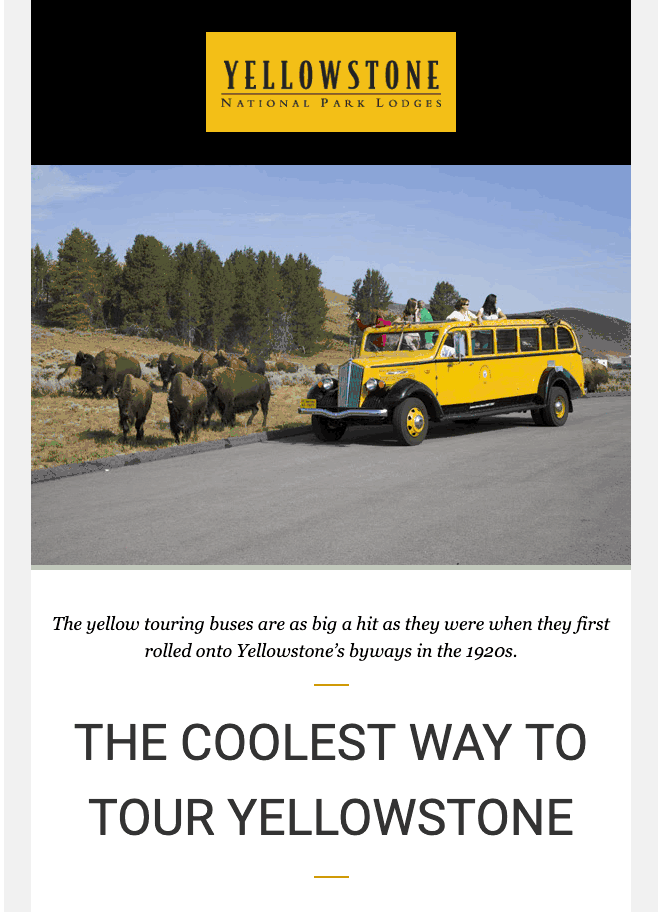
No matter who you are, or what you love about Yellowstone National Park, this newsletter has something for you!
This newsletter is great because it includes a variety of content.
- Promotion of Yellow Tour Buses
- New fishing program
- Information on bear activity
- Warnings about getting too close to wildlife
- A Q&A with a park musician
- Job postings
- Featured gifts (colorful socks)
- Blogs
- Images
- Baby animal quiz (!!!)
The newsletter broadcast lets you package unrelated things into 1 email for your audience. The content can be anything that’s happening right now in your business. Interactive content, informational content, promotional content, and even job openings!
Think about it like a newspaper for your organization. Some people like the front page, some like the business section, some only read the sports or the cartoons. But there’s something in it for everyone.
2. Curate relevant information (Xfinity)
The Xfinity newsletter is shorter than Yellowstone’s, but the concept is the same.
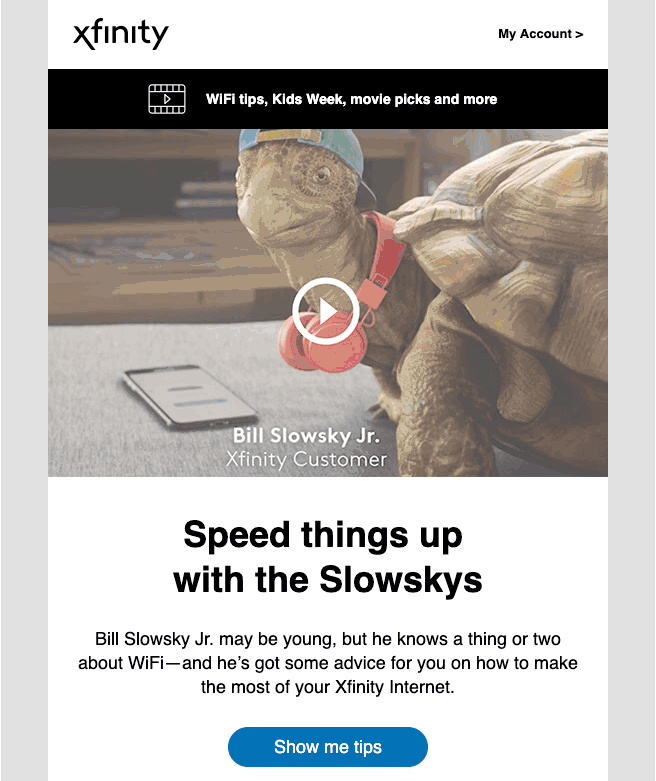
Xfinity’s newsletter lets you know what’s new this month, and touches on features that are relevant to the summertime!
Xfinity combines:
- Tips for getting the most out of their product/service
- Information on pausing WiFi to get your kids outside
- A list of shows for your kids to watch when they’re inside
- Top picks for when it’s cloudy in Chicago
The newsletter uses well known images and titles to grab and hold onto your attention. Xfinity knows that it’s summertime for everyone, and uses that to their advantage in the newsletter.
They know that children are more likely to be home during the day in the summer months, and also more likely to be watching TV. With this in mind, they include the top picks for kids and a feature for parents to get their kids away from the TV.
Tips for getting your kids outside won’t be included in January’s newsletter, because that would be irrelevant (and dangerous in Chicago, burrrr).
3. Give multiple subscription options (Search Engine Journal)
It’s important to keep your newsletters focused and relevant on your business. Search Engine Journal does this especially well. Take a look:

Everything in this newsletter has to do with marketing, SEO, and content
SEJ’s newsletter is focused on all things marketing with an emphasis on SEO. But SEJ takes the idea of consistency to a whole new level. Did you notice the question at the bottom of the newsletter?

How consistent do you want them to be?
Many organizations will send their newsletter on a set frequency. It could be daily, weekly, or monthly. SEJ goes above and beyond and says,
“We appreciate that you’re subscribed to our newsletter and we want to do what works best for you. How often do you want to hear from us?”
Beyond staying focused and consistent, another newsletter challenge is staying interesting. Grab your subscriber’s attention and optimize your newsletter for:
- Images
- Subject line
- Compelling language
- Negative space
Holding their attention results in higher email open rates and click through rates (CTR).
Newsletters are effective email broadcasts so long as you:
- Keep it focused
- Make it interesting
- Stay consistent
- Send quality information
4. It’s boring, but it’s important! (Yelp)

“We know it’s not the most exciting email, but this update is important for how you use our service.”
Yelp knows that hardly anyone reads through the fine print of a privacy policy or terms of service agreement, so they give you the highlights of the changes in the body of the email. It’s easy to see who the changes effect, and the audience appreciates simplicity.
It also makes the sender appear more transparent and trustworthy.
5. Some things have changed (Venmo)
Another example of a transparent policy update comes from Venmo:

“We updated our agreement, and these are the updates.”
Some email announcements are more fun than a privacy policy update or a change to your terms of service.
- What if you have a product update?
- What if you have some new services to offer?
And a broadcast email blast is the best way to clue everyone in at once.
Venmo, like Yelp, helps you out by explaining the changes in their policy. For the most part, these changes won’t affect how users interact with the platform. But that’s not the point. The point is that the changes could have an impact. And that’s why everyone gets the email.
6. Everyone is getting new stuff! (Amazon)
You don’t have to send an email every time there’s an update in your business.
You don’t get an email every time Netflix adds a new show, or every time Amazon adds a new product. If you did, your inbox would probably explode.
Instead, you can package several changes or updates together into a larger update email.
Amazon is a great example of the packaged membership update send. Here’s one I received a few weeks ago:
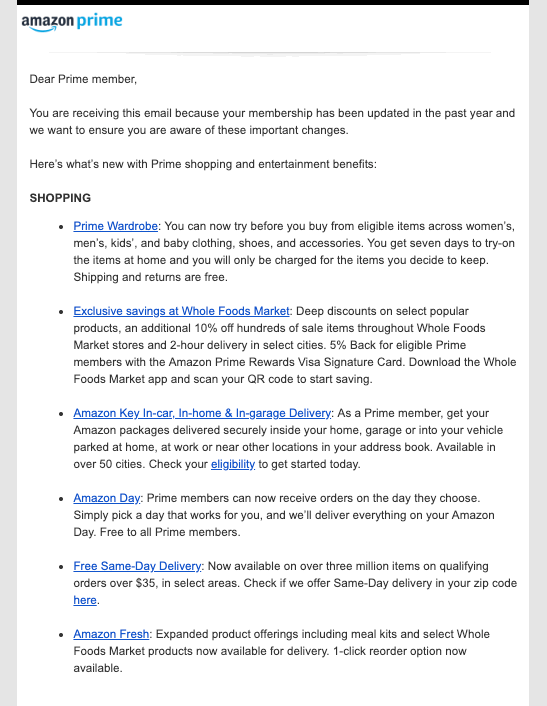
Amazon shares a range of updates, but groups updates by category to make the email easier to scan
Chances are that a percentage of Amazon’s customers already know about each perk. 1 new feature doesn’t warrant sending a broadcast email.
But combining 15 features? The chances that a random customer knows every feature is much slimmer.
The keys to the ‘important update’ email broadcast campaign are making sure that the email you’re about to send is important enough that everyone should know about it.
- Does it change how your business interacts with customers?
- Does it change how your customers interact with the business?
- Is it something that your customers have been asking for?
- Is the change significant enough to send an email?
If the answer is yes, then sending a policy update broadcast email is a good idea.
7. News from everywhere! (The Daily Carnage)
Take a look at this digest broadcast email from The Daily Carnage:

The Daily Carnage is a digest newsletter focused on marketing. You can view the entire digesthere.
The Daily Carnage is powered by Carney and each issue includes:
- Recent news
- Tips and tactics
- Tools to use
- Recommendations on things to watch
- A vintage advertisement
Each day has a new focus within the overall topic of “marketing”. The topic of July 31 was, “The Best Time to Post” and included information from 12 different sources.
Some other popular digests are:
Email digests are useful because they’re subscription-based. You know everyone on the list has an interest in the topic you’re covering.
Digests work to establish your credibility as a thought leader for a given topic, and they provide you with an audience to promote your own business services.
Don’t push your business too hard, though. Your subscribers signed up for diverse content, not to be bombarded with sales pitches. It’s an email digest, not an email Trojan Horse.
8. Recommended for you… (LinkedIn)
LinkedIn takes a different approach to the digest and picks the news for the individual. This results in a segmented digest that’s curated based on your activity and indicated interests.
Take a look:
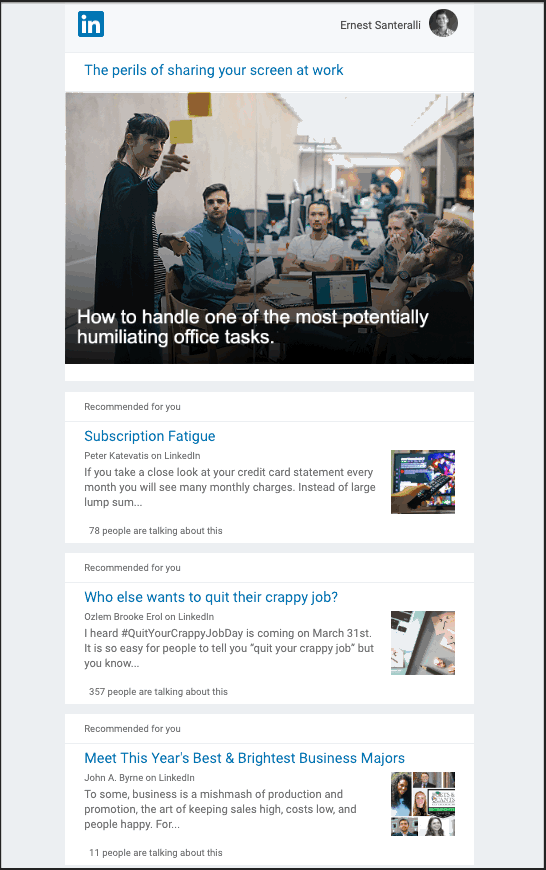
LinkedIn sends a personal digest using your interests, activity, and employment history
The curated digest uses the contact information you already have to determine which content, news, or topics to send.
LinkedIn uses the information they have to send curated broadcasts:
- My interests
- My employment history
- Things I’ve ‘liked’
- Where I went to school
- What I studied
- My age
These data points translate into a digest of articles that are particularly relevant.
9. Deals for everyone (J. Crew Factory)

40% off everything for everyone.
This promotional broadcast email from J. Crew is perfect as a broadcast. Here’s 40% off everything in the online store. And did you notice the caution tape or the note in the top-left corner? The sale ends tonight!
The best broadcasts are short-term or time-sensitive. This email works because everyone who found it in their inbox qualifies for the discount.
Even if you’re not in the market for a crewneck sweater or a floral sundress, it’s nice to know that if you wanted one you wouldn’t have to pay full price. It’s all on sale. All of it!
Move from broadcasts to “narrow”casts
Each of the 4 types of broadcast emails:
- Newsletters
- Updates
- Digests
- Promotions
can be refined or personalized so that each email is more targeted. The emails are still sent out to a list, but a smaller and more segmented list. It’s still a batch send or a ‘cast,’ but to a more narrow audience.
Why personalize? When you target your emails to a smaller group of your overall contacts, it’s easier to customize to their interests – so you can show people exactly what they want to see.
A personalized email feels personal, because it’s more relevant and looks like it was sent just to the receiver.
Search Engine Journal does exactly this. Beyond asking you how often you would like to hear from them, they ask you what you would like to hear from them. SEJ is moving from broadcasts to narrowcasts.

“We don’t want to waste your time with unwanted content, so tell us what you want!”
This means that your contacts and subscribers view your business as one that knows their personal interests and doesn’t treat them like everyone else. Narrowcasts are perfect for a nurture sequence.
The bulk email hasn’t been totally replaced, but don’t expect it to be the final solution for your marketing strategy. Here’s why:
- The broadcast email is less effective than trigger-based or behavioral emails that are highly personalized. 40% of executives surveyed by Forbes say that personalization efforts have significantly increased profits and sales
- Segment's Personalization report in 2017 found that 71% of consumers find impersonal experiences frustrating (AKA the broadcast email) and 44% of consumers say that loyalty is established with a personalized experience.
Experian found that personalized promotional mailings have 29% higher unique open rates and 41% higher unique click rates than non-personalized mailings
- Personalized, triggered mailings have similar lifts, with 25% higher unique open rates and 51% higher unique click rates
Because of this, brands are planning on sending more behavioral based emails instead of broadcast emails like newsletters.

Personalization goes a long way to turning prospects into customers into repeat customers (Source)
Autoresponders and triggered email campaigns
Email marketing automation tools like ActiveCampaign help to bring together the different types of marketing emails into your overall strategy. Autoresponders and other triggered emails are helpful to combine with email broadcasts.
Email autoresponder campaigns are triggered by customer actions. When a contact
- Submits a form
- Registers for an event
- Signs up for your newsletter
ActiveCampaign will send them an email thanking them or confirming their action.
Triggered emails are emails sent automatically when a particular action takes place. Autoresponders are one type of triggered email, some others include sending an email when a contact:
- Opens an email
- Clicks a link
- Visits a website
- Reaches a certain level of engagement
Combining broadcast emails with other types of email automation works to increase the effectiveness of your email marketing strategy. You’ll notify your entire list of important news and offers, while also giving each contact a personalized experience.
Conclusion: When do you use broadcast emails?
General broadcast emails are in large part being replaced by segmented, narrowcast emails. Today’s consumers crave a personalized experience that the generalized email blasts don’t give.
When your entire list of subscribers needs to know something, a broadcast email does the job better than any other type of email. Those situations are:
- News updates
- Important updates
- Digests
- Sales and promotions
Each of these broadcast types will perform better with some level of segmentation, but the broadcast email still has a place within an effective email marketing strategy.





